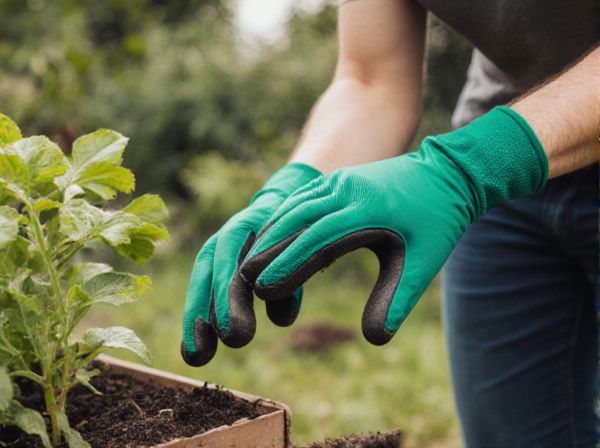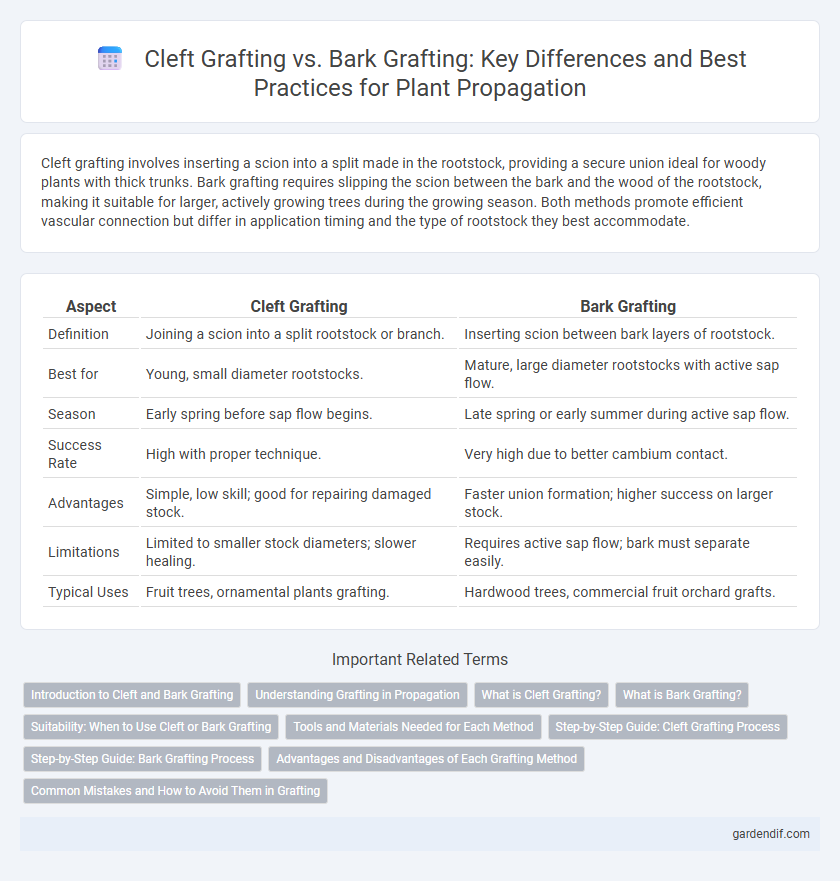
Cleft Grafting vs Bark Grafting Illustration
Cleft grafting involves inserting a scion into a split made in the rootstock, providing a secure union ideal for woody plants with thick trunks. Bark grafting requires slipping the scion between the bark and the wood of the rootstock, making it suitable for larger, actively growing trees during the growing season. Both methods promote efficient vascular connection but differ in application timing and the type of rootstock they best accommodate.
Table of Comparison
| Aspect | Cleft Grafting | Bark Grafting |
|---|---|---|
| Definition | Joining a scion into a split rootstock or branch. | Inserting scion between bark layers of rootstock. |
| Best for | Young, small diameter rootstocks. | Mature, large diameter rootstocks with active sap flow. |
| Season | Early spring before sap flow begins. | Late spring or early summer during active sap flow. |
| Success Rate | High with proper technique. | Very high due to better cambium contact. |
| Advantages | Simple, low skill; good for repairing damaged stock. | Faster union formation; higher success on larger stock. |
| Limitations | Limited to smaller stock diameters; slower healing. | Requires active sap flow; bark must separate easily. |
| Typical Uses | Fruit trees, ornamental plants grafting. | Hardwood trees, commercial fruit orchard grafts. |
Introduction to Cleft and Bark Grafting
Cleft grafting involves inserting a scion into a split made in the rootstock, making it ideal for joining smaller scions to larger rootstocks during early spring when sap flow is active. Bark grafting requires peeling back the bark of a mature rootstock and inserting scions between the bark and wood, suited for larger diameter rootstocks and typically performed in late spring to early summer. Both methods enable effective propagation of fruit trees, with cleft grafting offering strong cambial contact and bark grafting allowing multiple scions on one rootstock.
Understanding Grafting in Propagation
Cleft grafting involves inserting a scion into a V-shaped cut made in the rootstock, ensuring cambium layers align for successful nutrient transfer, which is ideal for joining smaller scions to larger rootstocks. Bark grafting requires peeling back the bark of the rootstock to insert multiple scions, commonly used for top-working mature trees or repairing damaged limbs. Understanding the cambial contact and compatibility between scion and rootstock is crucial in propagation, as it directly affects graft union strength and plant growth outcomes.
What is Cleft Grafting?
Cleft grafting is a propagation technique used to join a scion onto the rootstock by splitting the stock vertically and inserting the scion into the cleft. This method is ideal for repairing damaged trees or changing varieties and is commonly applied in dormant woody plants such as fruit trees. Cleft grafting ensures vascular cambium alignment between the stock and scion, promoting successful nutrient transfer and growth.
What is Bark Grafting?
Bark grafting is a propagation technique where a scion is inserted between the bark and the wood of a rootstock, allowing the cambium layers to unite and promote new growth. This method is particularly effective during the active growing season when the bark easily separates from the wood, enabling successful graft union formation. Compared to cleft grafting, bark grafting is commonly used for larger rootstocks and is favored for repairing damaged trees or top-working established plants.
Suitability: When to Use Cleft or Bark Grafting
Cleft grafting is most suitable for repairing damaged tree trunks or joining small scions to larger rootstocks during early spring when the bark is not slipping. Bark grafting excels in late spring or early summer on actively growing trees with fully slipping bark, facilitating better cambial contact for successful union. Selecting cleft grafting benefits woody plants with stiff bark and narrow branch angles, while bark grafting works better for broader, vigorous rootstocks requiring strong, rapid graft establishment.
Tools and Materials Needed for Each Method
Cleft grafting requires a sharp grafting knife, grafting wax, a mallet, and rootstock with a clean, straight cut split to insert the scion. Bark grafting utilizes a sharp knife, grafting tape or rubber strips for binding, and often requires larger diameter rootstock with bark that easily separates for scion insertion. Both methods benefit from clean cuts and sterilized tools to prevent infection and ensure successful graft union.
Step-by-Step Guide: Cleft Grafting Process
Cleft grafting involves splitting the rootstock stem and inserting a scion wedge into the cleft, ensuring cambium layers align for optimal nutrient flow and successful union. After inserting the scion, secure the graft with grafting tape or wax to prevent moisture loss and infection, promoting effective callus formation and tissue healing. Regular monitoring and protection from environmental stressors accelerate growth and improve graft take rates compared to bark grafting, which requires bark to be actively separating.
Step-by-Step Guide: Bark Grafting Process
Bark grafting begins by selecting a healthy rootstock and making a vertical cut through the bark to expose the cambium layer. Next, prepare the scion by cutting a wedge-shaped end that matches the length of the rootstock's exposed area, then insert it carefully between the bark and wood. Finally, secure the graft union with grafting tape or rubber bands, apply grafting wax to prevent moisture loss, and ensure the grafted plant is kept in optimal humidity and temperature conditions for successful healing.
Advantages and Disadvantages of Each Grafting Method
Cleft grafting offers precise cambium alignment, making it suitable for repairing damaged rootstocks, but it requires dormant stock and can be labor-intensive. Bark grafting allows for larger scion insertion on actively growing rootstocks, enabling higher success rates in spring, though it has limitations in colder climates and may result in slower initial union formation. Both methods depend on proper sealing and environmental conditions to prevent desiccation and infection, affecting overall graft success.
Common Mistakes and How to Avoid Them in Grafting
Common mistakes in cleft grafting include improper alignment of cambium layers and using incompatible rootstock, which hinder successful union and nutrient flow. Bark grafting errors often involve cutting the bark too deeply or during the wrong season, resulting in poor callus formation and graft failure. To avoid these pitfalls, ensure precise cambium contact in cleft grafts, select compatible rootstocks, and perform bark grafting during active growth when the bark slips easily.
Cleft Grafting vs Bark Grafting Infographic

 gardendif.com
gardendif.com